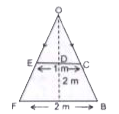For formation of shadow, the object in the path of light should be-
Transparent
Opaque
Translucent
None of these.
To solve the question about the formation of shadows, we need to understand the properties of different types of objects in relation to light.
1. Understanding Light and Shadows:
- A shadow is formed when an object blocks the path of light.
2. Types of Objects:
- Transparent Objects: These are materials that allow light to pass through completely. Examples include clear glass or water. Since they do not block light, they do not form shadows.
- Opaque Objects: These are materials that do not allow light to pass through. Examples include wood, metal, or stone. Since they block light, they are capable of forming shadows.
- Translucent Objects: These materials allow some light to pass through but not all. Examples include frosted glass or wax paper. They can create a shadow, but it will be less defined compared to an opaque object.
3. Conclusion:
- For a shadow to be formed, the object must be able to block the light completely. Therefore, the correct type of object that should be in the path of light for shadow formation is an opaque object.
4. Final Answer:
- The object in the path of light should be opaque.
- A shadow is formed when an object blocks the path of light.
- Transparent Objects: These are materials that allow light to pass through completely. Examples include clear glass or water. Since they do not block light, they do not form shadows.
- Opaque Objects: These are materials that do not allow light to pass through. Examples include wood, metal, or stone. Since they block light, they are capable of forming shadows.
- Translucent Objects: These materials allow some light to pass through but not all. Examples include frosted glass or wax paper. They can create a shadow, but it will be less defined compared to an opaque object.
- For a shadow to be formed, the object must be able to block the light completely. Therefore, the correct type of object that should be in the path of light for shadow formation is an opaque object.
- The object in the path of light should be opaque.
Topper's Solved these Questions
Similar Questions
A clever student has used the concept of formation of shadow to determine the height of a long pole (OA). There was an electric bulb at the top of the vertical pole. The student placed an object of length 1 m at a height of 2 m from the ground as shown in the figure. The size of the shadow formed on the ground is 2 m. Determine the length of the pole.

View SolutionFormation of shadows is a consequence of _______ light.
View Solution
Knowledge Check
The optical path difference between two identical light waves arriving at a point (P) on the screen is 27×10−7m. For P to be a dark point, the wavelength of light used should be
A3000 ÅB4000 ÅC5000 ÅD6000 ÅFor the formation of covalent bond, the different in the value of electronegativities should be
AEqual to or less than 1.7BMore than 1.7C1.7 or moreDNone of theseFor the developments or formation of concept in the student , the teacher should
Afollow simple to complex method of teachingBprovide opportunity to the student of simple experienceCprovide opportinity to the student for transfer of formed conceptsDfollow all the above activities
The path of light is straight line.
View SolutionThe path of light is straight line.
View SolutionFor the formation of covalent bond, the difference in the value of electronegativities should be
View SolutionPrimary objective of Assessment should be:
View SolutionAs the object moves closer to a light source, the shadow
View Solution
